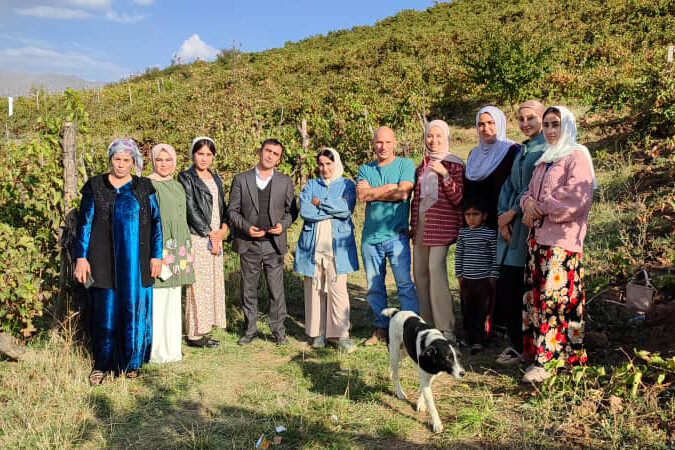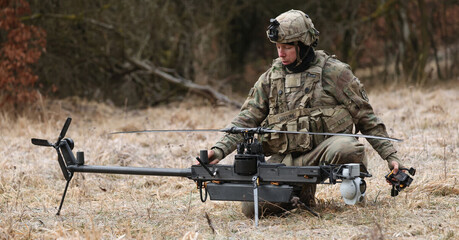
Khudoidod Rasulov's teaching vocation and his early interest in information technology make him a particularly valuable figure in his village of Lolazor, about 30 kilometers east of Dushanbe, the capital of Tajikistan. He is the person to whom all the villagers turn when they need information to better cultivate their orchards and market their products online. That is why it is not surprising that he played a key role when the Food and Agriculture Organization of the United Nations (FAO) launched its Digital Villages Initiative in Lolazor.
"In general, I am passionate about learning about mobile devices... and as a teacher, I have free time after work to help my fellow villagers," explains Khudoidod.
"Digital technology helps farmers solve agricultural problems and access the information needed for farm management."
Like most villagers, Khudoidod and his family are also farmers. But before heading out to spend the day in the fields, Khudoidod checks the weather forecast on his smartphone to see what the day holds.
In the afternoon, when he finishes teaching at the local elementary school, he heads to his plot to help till the land and weed between the rows of cucumbers, tomatoes, and potatoes. Then he waters the crops and prunes the apple, cherry, and apricot trees.
Whether for his own family or for other villagers, Khudoidod constantly uses the internet in general and agricultural platforms in particular to "recommend the best technologies for producing crops and fruits." He describes how "by analyzing websites and agricultural platforms, I advise on how to obtain better seeds and mineral fertilizers for growing vegetables and fruits, with the aim of obtaining abundant harvests. By using digital technologies, I am introducing advances in the agricultural activities of the village."
Much of this knowledge comes from the four digital technology training sessions provided by the FAO under the Digital Villages Initiative. But there was much more. Khudoidod also learned to advertise the agricultural products of his family and other villagers on social media platforms. He also mastered an application that provides farmers with comprehensive information on planning field activities.
This digital technology helps us with "the timely execution of field work, such as information on seedlings, fruits and vegetables and other types of products, the time of sowing and also the time to use mineral fertilizers in the cultivation of fruits and vegetables," explains Khudoidod.
The inhabitants of Lolazor use digital technology for online marketing of products and maintenance of greenhouses. © FAO (left/top) and © FAO/Daniil Dolidze (right/bottom)
Before, agriculture posed many challenges —such as when to use mineral fertilizers, when to irrigate and give treatments against insects and diseases— for which the villagers could have had expert advice, but they had none at hand, he says. Now, information technology has put the answers at their fingertips.
When a neighbor, Farahnoz Ganieva, has a question about one of the applications taught during digital training, Khudoidod guides her: "...let's take a look at the grape orchard section... look at the 'costs' and 'benefits' icons. They will help you control your expenses and income. By entering data about your orchard, you can make a rough prediction of costs and potential benefits."
He also played an active role in the project as a community mobilizer. Khudoidod was chosen as the administrator of a community Telegram channel called "Lolazor digital." This channel—through which villagers exchange information about their daily agricultural problems and solutions—was created by the instructor during digital training.
Khudoidod and other Lolazor villagers visit the Fergana Valley in Uzbekistan to share experiences and learn best practices. Uzbekistan is another Central Asian country where the FAO is implementing the Digital Villages Initiative. © FAO/Daniil Dolidze
But his dreams go further. After training, Khudoidod—who lives with a disability—aspires to open his own technology store and provide training sessions to improve the digital literacy of his community members and neighboring communities.
He comments on a three-day study visit to the Fergana Valley in Uzbekistan, another Central Asian country where the FAO is implementing the Digital Villages Initiative. He says he had the opportunity to meet wonderful people who have now become his friends.
The experience—particularly the well-organized greenhouse for growing lemons, full of smart sensors with Internet of Things technology—left him full of enthusiasm and hope for the future of his community. With his skills and willingness to help his fellow villagers benefit from digital innovation, Khudoidod is a key asset in shaping that future.
[Copyright (c) Global Economic Times. All Rights Reserved.]




























